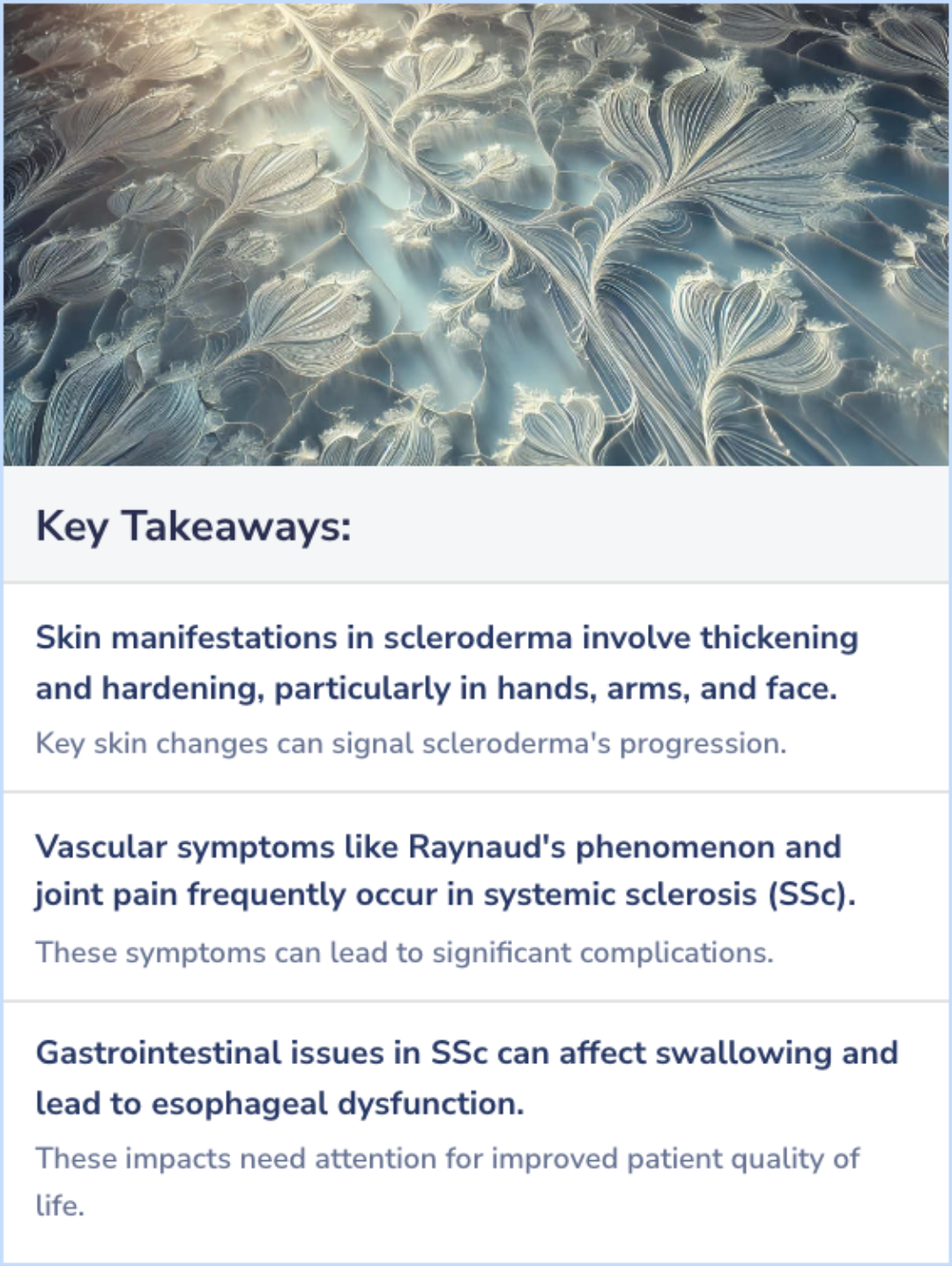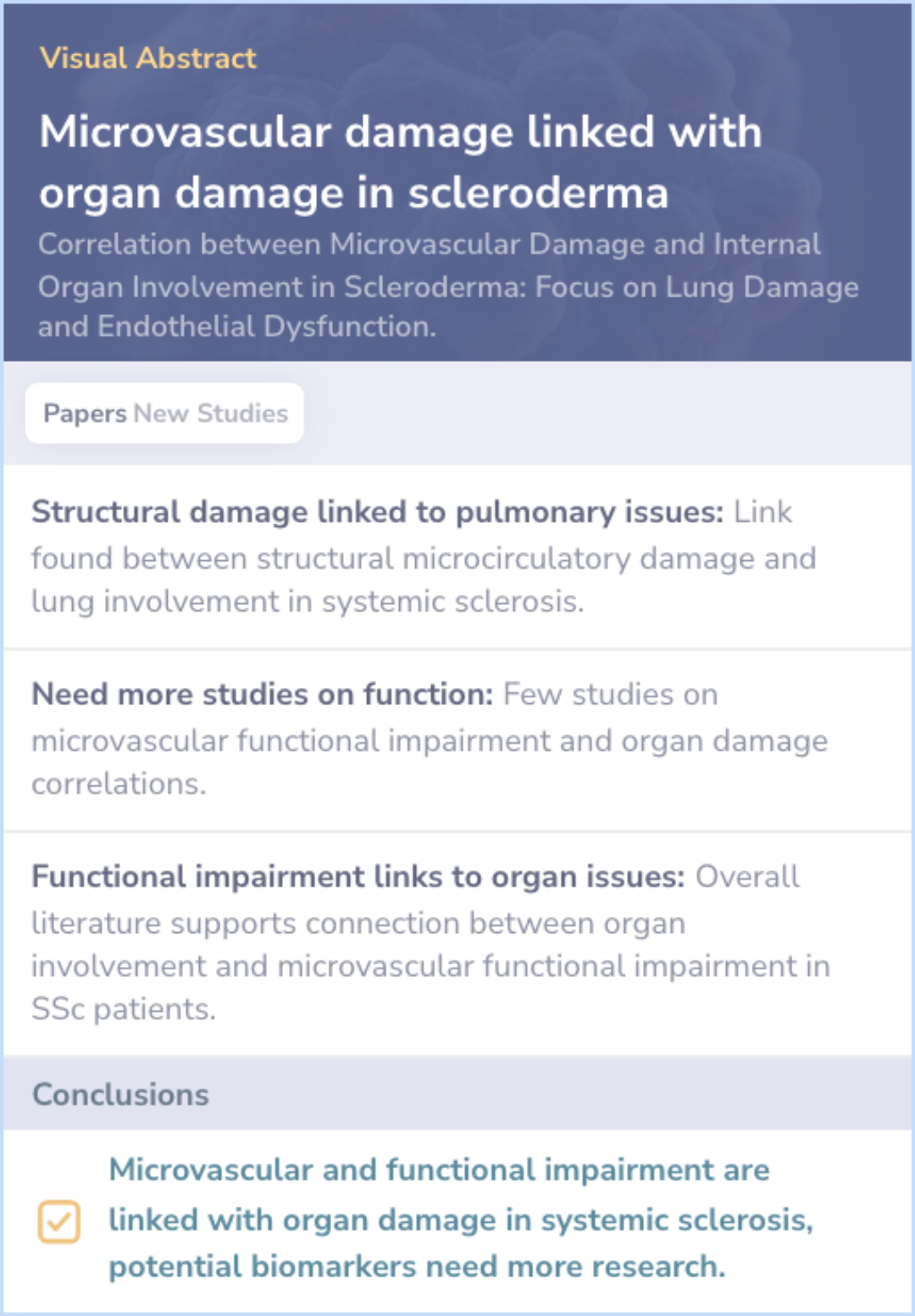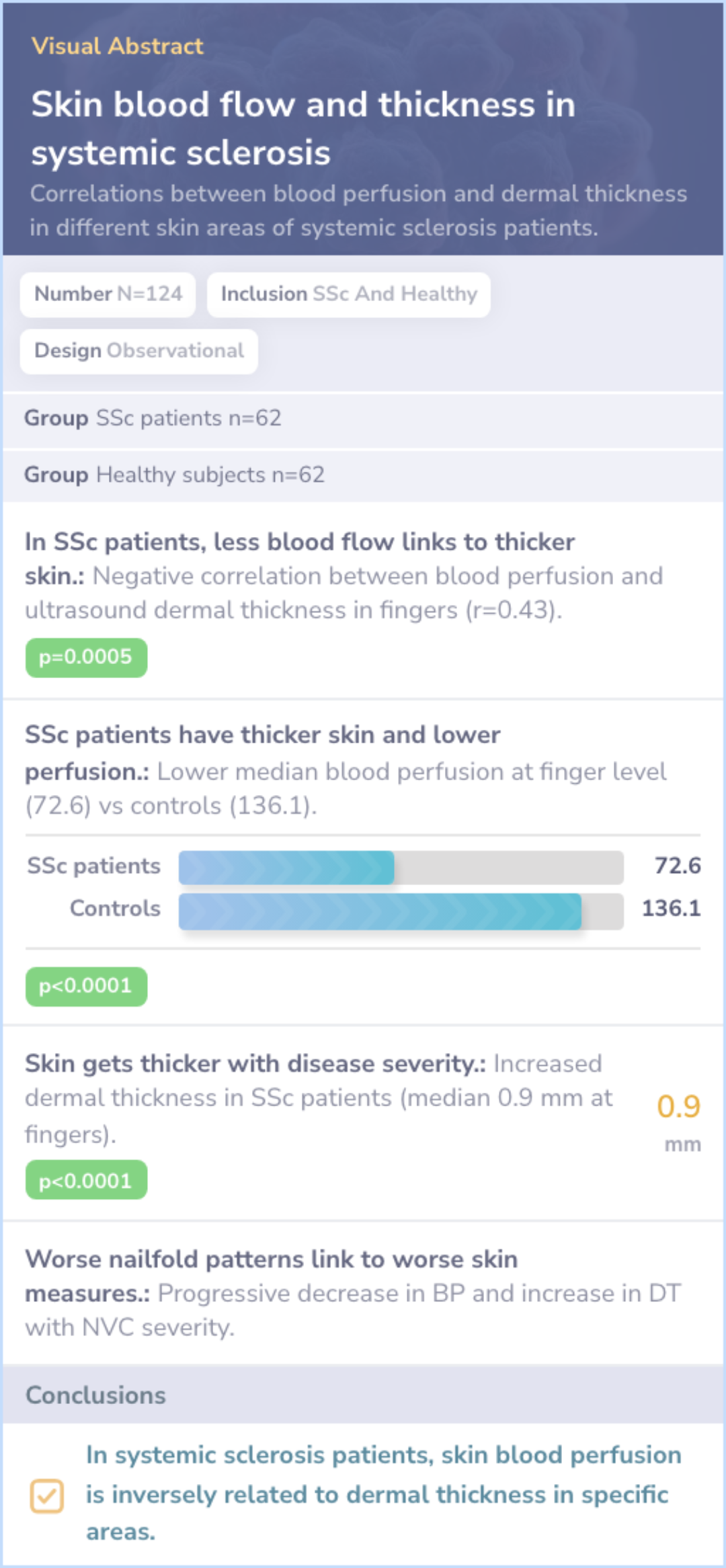Scleroderma
Evidence Based Answers
Understanding Scleroderma Symptoms
Scleroderma significantly impacts patients with skin thickening, vascular issues like Raynaud's, joint problems, and widespread gastrointestinal disturbances. These symptoms require careful management to improve quality of life.

Scleroderma symptoms include skin thickening, Raynaud's, joint pain, and gastro issues.
Recognizing Skin Changes in Scleroderma
Scleroderma often causes the skin to thicken and harden, with nearly all systemic sclerosis (SSc) patients experiencing varying levels. Initial symptoms might include puffiness in the hands or fingers, escalating to significant skin thickening.
Limited cutaneous SSc usually affects the skin on the hands, arms, and face but not the chest or abdomen. This characteristic helps differentiate between limited and diffuse types of the disease.
Limited cutaneous SSc usually affects the skin on the hands, arms, and face but not the chest or abdomen. This characteristic helps differentiate between limited and diffuse types of the disease.
“
Source Quotes:
The term scleroderma is used to describe the presence of thickened, hardened skin (from the Greek 'scleros').,Skin involvement is a nearly universal feature of SSc. It is characterized by variable extent and severity of skin thickening and hardening.
Skin signs of scleroderma may include: Fingers or toes that turn blue or white in response to cold temperatures (Raynaud phenomenon),Small white lumps of calcium beneath the skin that sometimes ooze a white substance that looks like toothpaste.
Vascular and Muscular Effects in Scleroderma
Systemic sclerosis (SSc) affects both blood vessels and muscles. Raynaud's phenomenon, a common vascular symptom, changes skin color when exposed to cold or stress. Digital ulcers may develop and cause infection.
The musculoskeletal system can also be impaired, showing joint pain, stiffness, and swelling, particularly in hands and feet. This can lead to reduced mobility or sensations like numbness.
The musculoskeletal system can also be impaired, showing joint pain, stiffness, and swelling, particularly in hands and feet. This can lead to reduced mobility or sensations like numbness.
“
Source Quotes:
RP is virtually always present in patients with SSc and can predate other disease symptoms by years, particularly in limited SSc.,Digital ulcers are ultimately develop in up to 50 percent of patients. In general, digital ulcers are associated with a worse disease course.
Bone and muscle symptoms may include: Joint pain, stiffness, and swelling, resulting in loss of motion. The hands are often involved due to fibrosis around tissue and tendons.
Gastrointestinal Issues in Scleroderma
Approximately 90% of systemic sclerosis (SSc) patients have gastrointestinal (GI) involvement, with symptoms affecting about half. These may include swallowing difficulties and heartburn, with severe cases presenting as esophageal dysfunction or gastroparesis.
Esophageal dysfunction can cause major issues in the lower esophagus, affecting its movement. Other common GI symptoms are bloating, constipation, diarrhea, and malnutrition, which can drastically impact a patient's quality of life.
Esophageal dysfunction can cause major issues in the lower esophagus, affecting its movement. Other common GI symptoms are bloating, constipation, diarrhea, and malnutrition, which can drastically impact a patient's quality of life.
“
Source Quotes:
Nearly 90 percent of patients with systemic sclerosis (SSc) have some degree of gastrointestinal (GI) involvement, and approximately one-half are symptomatic.,The most common gastric manifestation of systemic sclerosis (SSc) is gastroparesis. Symptoms in patients with gastroparesis are due to delayed gastric emptying.
Common symptoms of gastrointestinal involvement include dysphagia and choking, heartburn, hoarseness, cough after swallowing, early satiety, bloating, alternating constipation and diarrhea, episodic pseudo-obstruction and bacterial small bowel overgrowth with malabsorption, and fecal incontinence.
Breathing and Kidney Issues in Scleroderma
Pulmonary issues in systemic sclerosis (SSc) include interstitial lung disease (ILD) and pulmonary arterial hypertension, which affect breathing. ILD causes fatigue, breathlessness, and a dry cough, often detectable through unique lung sounds or imaging.
Renal problems, especially scleroderma renal crisis, are serious health concerns. If untreated, they can lead to kidney failure, emphasizing the need for awareness about these symptoms.
Renal problems, especially scleroderma renal crisis, are serious health concerns. If untreated, they can lead to kidney failure, emphasizing the need for awareness about these symptoms.
“
Source Quotes:
Breathing problems may result from scarring in the lungs and can include: Dry cough, Shortness of breath, Wheezing, Increased risk for lung cancer
The most common symptoms of SSc-associated ILD are fatigue, breathlessness (ie, exertional dyspnea initially), and dry cough.
Key Takeaways
Conclusions
Scleroderma prominently affects the skin, causing thickening which is commonly observed in the hands, arms, and face, creating distinct classifications of the disease. Recognizing early cutaneous symptoms is significant in forecasting disease progression.
In addition, systemic sclerosis impacts vascular, musculoskeletal, and gastrointestinal systems, with Raynaud's phenomenon and joint pain being common. Gastrointestinal symptoms, including swallowing issues and esophageal dysfunction, are widespread, impacting patients' quality of life.
Pulmonary and renal complications, such as interstitial lung disease and renal crisis, underscore the importance of early symptom identification for effective management strategies aimed at preventing further damage.
In addition, systemic sclerosis impacts vascular, musculoskeletal, and gastrointestinal systems, with Raynaud's phenomenon and joint pain being common. Gastrointestinal symptoms, including swallowing issues and esophageal dysfunction, are widespread, impacting patients' quality of life.
Pulmonary and renal complications, such as interstitial lung disease and renal crisis, underscore the importance of early symptom identification for effective management strategies aimed at preventing further damage.

Literature Review
D'Oria, 2022
Main Findings:
Structural microcirculatory damage: Strongly linked to lung involvement in systemic sclerosis.
Functional impairment studies: Fewer studies exist but link to organ damage is supported.
Emerging Biomarkers:Morphological and functional techniques may serve as future biomarkers but more research is needed.

Literature Review
Ruaro, 2018
Key Findings in Scleroderma:
Blood Perfusion and Skin Thickness: Inverse relationship in fingers of scleroderma patients.
Scleroderma vs. Healthy Subjects: Scleroderma subjects have lower blood flow and thicker skin.
Blood Perfusion and Disease Severity:Blood perfusion decreases and skin thickness increases as disease severity progresses.
